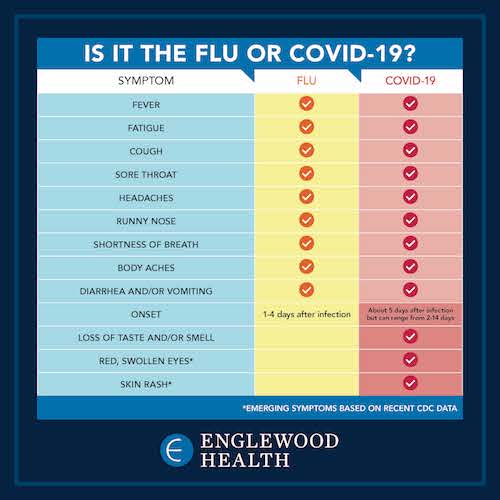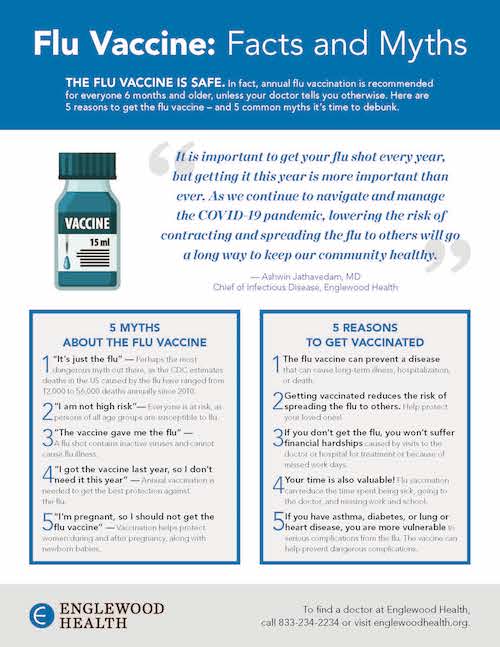Oh dear. You woke up this morning feeling terrible. Sore throat, cough, stuffy nose, and lethargy. Last year, you would have been wondering if you just had a cold or if you had come down with the flu. This year, there's the added concern that you might have been exposed to COVID-19. But how can you tell the difference? The Englewood Health team, leaders in the fight against COVID-19, have been working to help you tell what's what so you can take the right action for your safety and well-being. The health system's "Healthy Talk" community update earlier this season featured infectious disease experts breaking down COVID-19 and family safety. Watch the full video to learn more about what you need to know and what you can do to stay healthy.
Here are some of the most important takeaways:
Turns out, the flu and COVID-19 look very much the same when symptoms first present: fever, fatigue, cough, sore throat, headaches, runny nose, shortness of breath, body aches, and diarrhea or vomiting. The most notable differences are loss of taste and/or smell; red, swollen eyes; skin rash; and the timing of the onset of symptoms. That’s why it’s important to keep track of your activities and contacts in order to pinpoint when and where you might have been exposed. It’s also important to follow the safety guidelines that have been proven to mitigate your family’s exposure to both viruses. Unfortunately, these guidelines don’t really make it easy to see family and friends over the holidays. But as Dr. Stephen Brunnquell, president of the Englewood Health Physician Network says, there hasn’t been a time in recent history when we have needed the cooperation and support of friends and family more. So what to do?

The experts at Englewood Health say: Play it safe and stick to your household. Check out their Winter Holiday Safety video for some practical advice and important suggestions on how to celebrate with family and friends as safely as possible.
Their advice includes:
- Open windows, turn on exhaust fans, and place central air and heating on continuous circulation.
- Wear masks if you are indoors or in close quarters outdoors.
- Don’t eat at the same table with others not in your immediate family.
- Sorry, no family style meals this year. Prepare individual portions so guests don’t all need to touch the serving utensils.
- Consider supplying single-use hand towels in your bathrooms and remind guests to wash their hands for 20 seconds or more before and after eating and drinking.
- Have hand sanitizer stations located around your house. Hand sanitizer should be at least 60% alcohol to be most effective.
But back to the flu. Or is it COVID? First of all, put that mask on to protect yourself and others. Seriously -- wherever you go! Second, make sure you and those in your household get the flu shot, as it is more important that ever this year. Englewood Health experts remind you that the flu shot contains inactive viruses and cannot cause flu illness, and that annual vaccination is needed to ensure the best protection. Third, if you do start to show symptoms of…well, something, contact your physician. They will advise you regarding COVID testing, isolation, and any necessary treatment or course of action. But most of all, don’t panic. When you need them, the doctors and professional staff at Englewood Health are here to help with a track record of successful treatment for COVID-19 and the flu. They’ll help your family stay safe and stay healthy. Happy Holidays!

For more information, follow Englewood Health on social media (@englewoodhealth on Facebook and Instagram and @englewoodhosp on Twitter) and check out the following posts you can share to keep friends and family informed:
Is it the flu or COVID-19? Here's how to tell the difference: Facebook, Twitter, Instagram
Flu vaccine facts and myths: Facebook, Twitter, Instagram

![COVID-19, the Flu, and You. Englewood Health is here to help. [dedicated]](/images/jcogs_img/cache/Englewood_Health_Covid_Flu_-_28de80_-_bad689a073d7fa8264527fc238b51bfc11a463a4_lqip.png)



